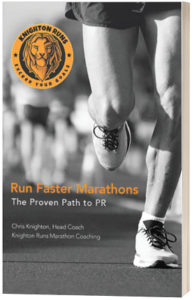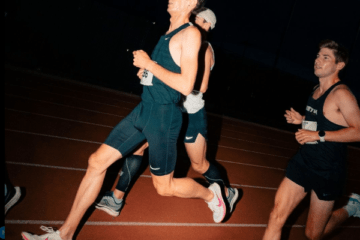Track Running 101 – A Beginner’s Guide to Track Workouts
Want to give track running a try? Here’s a quick guide to get you started.
Author: Coach Chris Knighton

Disclosure: This article may contain affiliate links. When you buy through links on our site, I may earn an affiliate commission. As an Amazon Associate I earn from qualifying purchases.
INTRODUCTION
Running on the track provides athletes with the best environment to develop their sense of pace and dial in their goal racing speeds.
Many athletes have access to precisely measured 400-meter outdoor running tracks, which are common at schools and parks across the United States. But for many, running on the track can be a daunting experience at first.
If you are new to track running, it’s normal to be unsure of proper track etiquette and protocol. In this article, you’ll learn all you need to know to confidently run your first track workout.
WHY RUN ON THE TRACK?
Running on the track has two very important benefits.
First off, there is no better way to hone in your goal race-pace than by running on a track. A track offers a smooth surface over a measured distance. GPS watches are often inaccurate when it comes to your pacing, but a track always tells the truth.
Secondly, running on the track allows you to develop an innate sense of pace. Runners should not be slaves to their GPS watch if they want to perform best. GPS frequently does not function accurately when it is most needed, and can not account for how the external effects of heat, wind, and humidity affect your exertion levels.
By performing track workouts over various intensity levels and in different weather conditions, you will with practice learn intuitively what those different effort levels feel like. On any given day, refer to your watch to help with pacing for your first couple of track intervals, but then run “by feel” and see if you can match the intensity the workout is meant to be run at.
HOW FAR IS ONE LAP?
It will depend on the size of the track and whether you’re on an indoor or outdoor track for how many laps make a mile. For example, it is clearly posted on the indoor track that I have used that 8 laps equal a mile.
For most outdoor tracks, 4 laps around the track equal 1,600 meters or roughly 1 mile. Likewise, 2 laps equal roughly ½ mile, and 100 meters is the length of one straightaway. These are typically the measurements you will see on the track. You may see additional markings on your track that designate the specific starting points of measured distances. For example, the one-mile starting point is usually about 9 meters before the 1600m starting point.
If you’re using a standard, Olympic-sized track, it measures 400 meters around only in lane one. Lane one is the lane nearest to the inside of the track. For each lane you go out from the innermost one, you add approximately 7 more meters per lap. That means that if you’re running on the outer edge of an outdoor track, you will end up running 453 meters or 1.12 miles over four laps.
Most outdoor tracks are Olympic-sized. Some outdoor tracks, especially those in public parks, may be longer, shorter, or irregularly shaped. If you’re not sure, it never hurts to ask another runner, research the track online, review the markings on the surface, or try to measure its distance with your GPS watch.
WHICH DIRECTION TO RUN?
Normally you will run counterclockwise on a track; however, some tracks may have special rules. For example, the indoor track that I use rotates direction every other day so that the wear on the track is even. This means that some days I run counterclockwise and other days clockwise.
If there is no sign indicating otherwise, then by default run counterclockwise. If you want to run against the normal flow of traffic, keep to the outside lanes.
If you are alone on the track, it’s okay and even recommended to alternative the directions you are running between clockwise and counter-clockwise to even out the effects of left and right-hand turns on your body.
HOW DO THE DIFFERENT LANES WORK?
Lane 1 is reserved for those running fastest at the track. Take a look around at who is using the track and determine if anyone is running faster than you. You may want to run your workout in lane 2 or 3 if faster runners are present, or at least move out of lane 1 when the faster runners come through.
Additionally, if you’re running on a school track when the cross country or track team is practicing, it is courteous to leave the innermost lanes to them and give them plenty of space. The school owns the track afterall.
When you’re warming up, cooling down, or recovery jogging between intervals, stay in the outer lanes and go to the very farthest one out if you’re going to be walking.
Finally, stay in the same lane when you’re running, unless passing a slower runner.
WHAT ISN’T ALLOWED?
It’s also standard procedure to leave your headphones at home. It should go without saying to leave your dog at home.
Another important rule is to avoid standing still on a track. You don’t want to be an obstacle for other runners on the track. Move to the outermost lane or go into the infield if you’ll be taking a break.
Also, if you bring your kids to the track, make sure that they aren’t wandering on the track and in the path of runners. Some tracks do allow jogging strollers, so if you have little ones, you might want to check and see if that is a possibility. Running with a stroller on a track is a great way to get your miles in while spending time with your kids. If other runners are present, you’ll want to stay in the outer lanes when using a jogging stroller due to your reduced agility.
WHAT IS PROPER PASSING ETTIQUITE?
Unless you are in a race against them, faster runners have the right of way. Please allow faster runners to pass you without trouble.
It’s appropriate to let runners in front of you know if you are passing on the inside. The typical phrases used are “track,” “on your left/right,” or “on the inside.”
Don’t be surprised if a faster runner passes you on the outside without saying anything. They may not have wanted to give notice they were coming. But you should allow them to pass on the inside if you are aware they are coming.
SUMMARY
After reading this article, you now know the basics of running on the track. You understand why running on the track is a valuable tool for locking into race pace and developing your internal feel for pacing. You know the basics of how a track is laid out and the etiquette and protocol for running on a track.
Now, all you got to do is get out there and practice. Give it a try and after a few workouts on the track, I guarantee you’ll feel like a pro.
Continue the conversation in the comments below
Are the rules different at your local track? Did we miss any key points of track etiquette or protocol? Let me know in the comments below.



